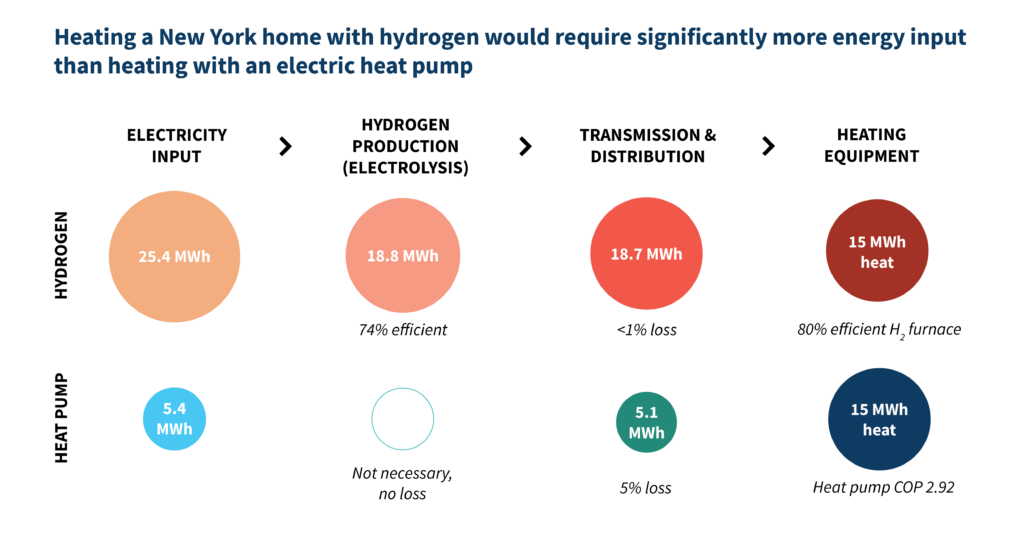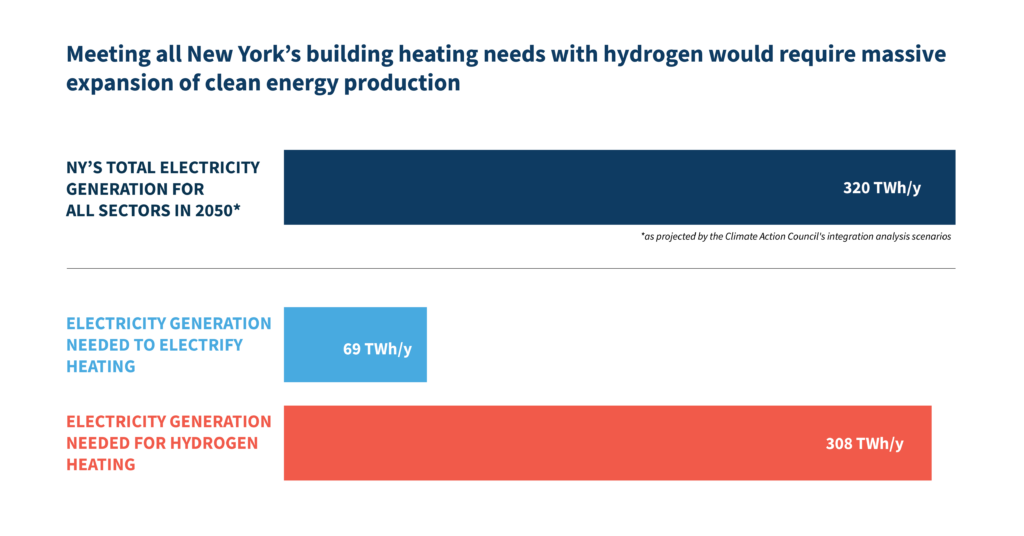
Low-Carbon Fuels Have a Limited Role to Play in New York’s Buildings
New York State is poised to become a national leader in climate action in the buildings sector, with an ambitious vision in the state’s draft climate plan for phasing out fossil fuel use in buildings through a mix of efficiency and electrification upgrades. As the state moves to finalize this plan, alternate proposals are emerging focused on “low carbon fuels” — namely hydrogen, biomethane, and synthetic methane — as options for building heating. This policy brief examines the challenges that make these fuels impractical for playing any significant role in heating buildings in New York, highlighting four points:
- Producing green hydrogen for heating buildings is an inefficient use of clean electricity.
- Hydrogen strategies for buildings also impose impractical infrastructure requirements, high heating costs, and human health hazards.
- Blending green hydrogen with biomethane does not scale and would not provide a carbon-free solution for New York buildings.
- Strategies centered on low-carbon fuels in buildings divert resources from urgently needed efficiency and electrification solutions.
Introduction
With the enactment of the Climate Leadership and Community Protection Act (CLCPA), New York State set some of the most ambitious climate goals in the country. The CLCPA mandates an 85% reduction in statewide greenhouse gas (GHG) emissions by 2050 compared to a 1990 baseline, with an interim goal of 40% by 2030. The law is also ambitious in the way that it requires emissions to be calculated. Unlike many jurisdictions, New York State law requires that emissions be calculated using the 20-year global warming potential metric (GWP-20) rather than the more commonly used GWP-100. Using the 20-year metric means that impacts from gases that have a shorter lifetime in the atmosphere, such as methane, are weighted more heavily.
Through the work of the Climate Action Council and the development of the Draft Scoping Plan, the state is setting the stage to implement the CLCPA and meet these climate targets. The initial modeling developed for the Draft Scoping Plan (known as the Integration Analysis) relies heavily on ambitious energy efficiency and electrification to eliminate the majority of buildings sector emissions across each scenario — including the low-carbon fuels pathway.[1] The policies to achieve this transition have not yet been locked in, however.
Note for this brief, we use the following definitions:
“Green hydrogen”: hydrogen produced by electrolysis that is powered by renewable energy sources.
“Biomethane”: methane sourced from biogenic feedstocks such as landfills, wastewater treatment plants, and food waste.
“Synthetic methane”: methane created from the reaction of carbon dioxide with green hydrogen.
Producing Green Hydrogen for Heating Buildings Is an Inefficient Use of Clean Electricity
Producing and burning hydrogen for building heat requires much more electricity generation than heating buildings directly with electric heat pumps. Exhibit 1 shows the step-by-step energy flows required to deliver a year’s worth of heating for a typical New York home with a gas furnace and gas water heater. Such a home might require about 50 MMBtu (equivalent to 15 MWh) of heating energy annually. Meeting this demand with green hydrogen would require over 25 MWh of clean electricity, due to the efficiency losses during the production of green hydrogen and the relative inefficiency of end-use appliances.[2] Using a high-performing electric heat pump could require as little as 5–6 MWh of clean electricity. That is, heating with green hydrogen would require about 4.4 times as much clean electricity as heating directly with a heat pump.
The consequences of this energy comparison are stark at a statewide scale. New York’s residential and commercial buildings currently consume about 828 TBtu of natural gas each year.[3] To meet that consumption with green hydrogen, New York State would need to build out additional clean electricity generation to produce 308 TWh/y for hydrogen production. Meeting that load via direct electrification with high-performing heat pumps would only require 69 TWh/y. For comparison, New York’s Climate Action Council anticipates about 320 TWh/y total electricity production for all sectors by 2050. The hydrogen heating pathway for buildings would require nearly this much generation just to displace gas in the residential and commercial sectors.
Hydrogen Strategies for Buildings Also Impose Impractical Infrastructure Requirements, High Heating Costs, and Human Health Hazards
Supply considerations aside, there are several other factors that make green hydrogen an impractical choice for heating the vast majority of buildings in New York:
Infrastructure
The majority of New York buildings are heated by fossil gas, which consists predominantly of methane and is delivered via a distribution pipeline system. Hydrogen, on its own, cannot be substituted 1-for-1 for fossil gas in either the pipeline system or in end-use appliances. The different physical properties of hydrogen gas can lead to metal pipeline embrittlement if high concentrations of hydrogen are transported via existing pipelines.[4] New York’s gas utilities currently operate nearly 49,000 miles of distribution pipeline, with over 22,000 miles of steel or cast-iron pipes, which could require upgrade or replacement to accommodate a high blend of hydrogen, adding additional costs and logistical challenges. For context, Con Edison has proposed spending $1.3 billion in 2023–2025 to replace just 255 miles of leak-prone pipe.
Inside buildings, millions of end-use appliances that currently burn fossil gas in New York would also have to be upgraded or replaced for a complete transition to green hydrogen. And in order for utilities to run green hydrogen through the distribution system, all appliances on that network would need to be upgraded in a coordinated fashion before hydrogen flows to customers. Hydrogen-capable furnaces, boilers, and water heaters do not have any notable market presence in New York today, so these appliances would also need to be commercialized and rapidly scaled. Continued investment in the gas distribution system — especially any investment predicated on future use of low-carbon fuels — risks sinking funds into a system facing declining usage and poses an opportunity cost when that investment could directly support proven and established carbon-free solutions like energy efficiency and electrification.
Cost
Beyond the potential billions of dollars in pipeline infrastructure replacement costs that would ultimately be borne by ratepayers, green hydrogen is an expensive fuel to produce for mass heating use. In the United States, green hydrogen costs around $5/kg today on average (or $37/MMBtu). With expected investments in green hydrogen technology, analyst forecasts and government targets point toward prices of $1–$2/kg as soon as 2030. However, that still equates to about $7.40–$15.00/MMBtu. New York’s Climate Action Council assumes in its analysis that green hydrogen will cost more than $21/MMBtu by 2030 and $13.70/MMBtu by 2050.
At these costs, widespread use of hydrogen for home heating would mean a major increase in energy bills for New York residents. For many customers, this compares to a status quo in which fossil gas prices have held in the $2–$3/MMBtu range for years before spiking to $6–$7/MMBtu in spring 2022, causing significant gas bill increases. Even before recent gas price spikes, heating with efficient cold-climate heat pumps was comparable in terms of energy costs to heating with fossil gas in New York, and gas price volatility has only made electrification more economically attractive. Furthermore, given New York State’s electrification goals, the customer base for the gas distribution network will inevitably shrink. Allowing costly investments in the gas system for the sake of integrating or converting to low-carbon fuels would leave a dwindling pool of customers on the hook for costly capital expenditures as well as a more expensive fuel.
Health
When combusted in buildings, hydrogen emits harmful air pollutants, such as nitrogen oxides (NOx), which can have significant health impacts. One study has shown that the NOx emissions resulting from burning green hydrogen can be up to six times the amount released from burning methane. Technical improvements may be able to reduce this hazard but require further investment and product development.
Blending Green Hydrogen with Biomethane Does Not Scale and Would Not Provide a Carbon-Free Solution for New York Buildings
Proposals to blend hydrogen with biomethane or synthetic methane face their own practical challenges, including the small emissions benefit of hydrogen blending, the limited availability of biomethane (also known as “renewable” natural gas, or RNG), and the emissions risks of both biomethane and synthetic methane.
Hydrogen blending with methane may be technically feasible up to 20% hydrogen by volume. However, given the relative energy densities of hydrogen and methane, a 20% blend would only reduce methane use by 7% and thus only achieve a 7% emissions reduction. While blending could reduce the scale of infrastructure upgrades needed in the pure hydrogen scenario, it would not eliminate the need for infrastructure upgrades altogether. Large capital investments in the gas delivery system would still be needed to accommodate this blend level — investments that compound the risk of stranded assets as more customers shift away from gas use.
There is also the unavoidable issue of supply availability for biomethane. A study of New York State RNG potential, conducted for the New York State Energy Research and Development Authority (NYSERDA), identified 90 TBtu/y of biomethane supply potential by 2040 in the “balanced” scenario, which is only 11% of the state’s buildings sector gas demand. Other studies, including National Grid’s clean energy vision report, assume biomethane is sourced from out-of-state and still rely on extremely optimistic expectations for growth in biomethane supplies.
Biomethane and synthetic methane also come with their own greenhouse gas emissions. Depending on the feedstock and method of production, biomethane production can create new sources of methane emissions. Among other factors, supply forecasts for biomethane typically include a significant amount of thermal gasification. In the New York biomethane study cited above, more than 60% of the supply projection comes via thermal gasification. Contrary to the frequent characterization that biomethane (or RNG) is sourced from “existing waste streams” or that the methane is “captured from the natural decomposition of organic waste,” thermal gasification requires intentionally creating methane that would not have otherwise existed as a waste product, often from purpose-grown energy crops that are not waste products at all.
By introducing new sources of methane, this process creates new methane emissions when leakage inevitably occurs in production, delivery, and at end use. Synthetic methane poses the same risks by introducing a new methane supply that would not have otherwise existed, creating new methane emissions that would impair or negate any life-cycle combustion emissions benefit. Finally, New York’s Department of Environmental Conservation has issued guidance that gross CO2 emissions from biomethane combustion will be accounted for in a manner consistent with emissions from fossil gas, negating the claim that this fuel is a carbon-free resource.
The risks for hydrogen-caused embrittlement are greatest in high-pressure steel transmission pipelines, but steel distribution pipes may also suffer long-term damage from concentrations of hydrogen. Source: Melaina, Antonia, and Penev, “Blending Hydrogen into Natural Gas Pipeline Networks: A Review of Key Issues,” NREL, March 2013.
Strategies Centered on Low-Carbon Fuels in Buildings Divert Resources from Urgently Needed Efficiency and Electrification Solutions
The Climate Action Council’s Draft Scoping Plan emphasizes efficiency and electrification as core strategies for decarbonizing buildings, as do other recent studies including Princeton University’s Net Zero America report and New Jersey’s Energy Master Plan. Strategies relying on hydrogen, biomethane, and synthetic methane require extensive spending on gas distribution infrastructure and new production facilities for those gases. These investments come at substantial opportunity cost at a time when New York’s buildings require energy efficiency and electrification upgrades to meaningfully address their greenhouse gas emissions. Green hydrogen offers substantial value in decarbonizing other sectors, especially in industrial processes, but represents a costly distraction from more effective solutions in the buildings sector.
New York’s climate planning, including the final scoping plan from the Climate Action Council due out later this year, must clearly confront the limits of hydrogen and biomethane in heating buildings and emphasize strategies to rapidly scale more effective solutions such as efficiency and electrification. This clarity will be crucial for advancement of meaningful policies that upgrade the state’s buildings for high efficiency, stop the expansion of gas use, and ramp up programs to rapidly convert from gas heating to efficient electric alternatives powered by clean energy.
Footnotes:
[1] The Strategic Use of Low Carbon Fuels, Accelerated Transition away from Fossil Fuels, and Beyond 85% Reduction scenarios each assume 92% of buildings will be electrified by 2050.
[2] “Making the Hydrogen Economy Possible: Accelerating Clean Hydrogen in an Electrified Economy,” Energy Transitions Commissions, April 2021, p. 16.
[3] This figure refers to average residential and commercial natural gas consumption in 2017–2021, per EIA data.
[4] Pipeline embrittlement refers to the degradation of a metal pipeline, including cracking, blistering, hydride formation, and loss in tensile ductility, due to reactions between hydrogen gas and the pipeline material.

